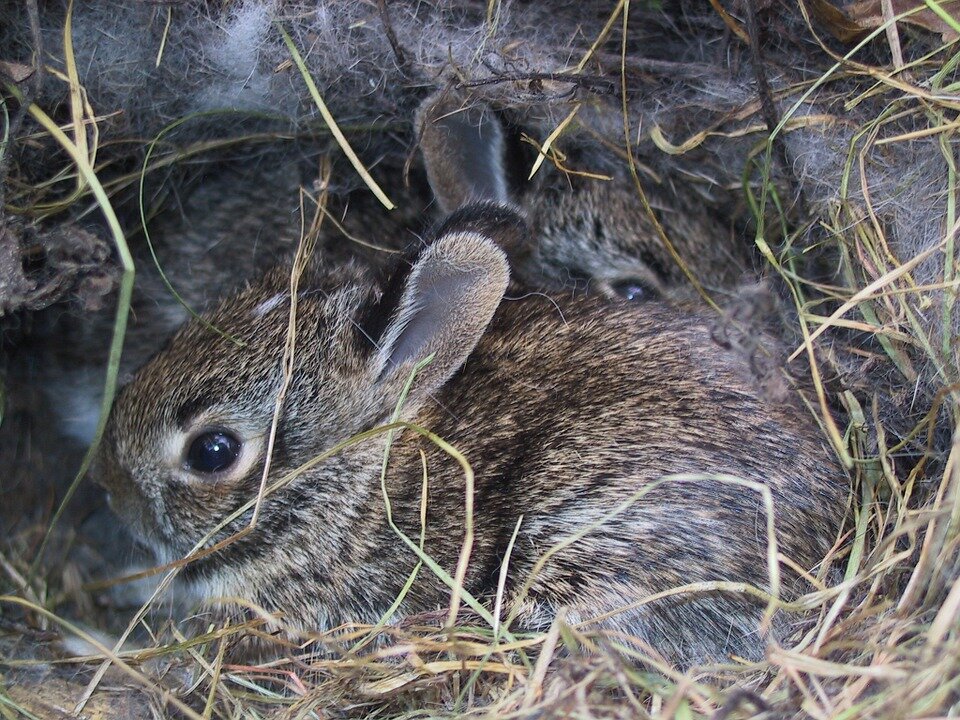Springtime Babies: Rabbits
Spring is here! For wildlife, this means it’s baby season. Our wildlife are starting to make their nests and have their babies. Since you’re probably staying home more often than usual, you’re more likely to come across these animals.
It can be very confusing and distressing to find a nest or a young animal on its own, especially when it’s a baby rabbit. We’re sharing some information about these animals and what to do if you find a baby rabbit.
Rabbits and Their Babies
Here in Northwest Indiana, the species of rabbit you’ll see is the Eastern Cottontail. These rabbits have their babies in early spring to summer. They protect their babies by hiding them in camouflaged nests. Rabbit nests are simply shallow holes in the ground lined and covered with dried grass, the mother’s fur, and dead leaves.
Since the nest is so small, the mother will only visit the nest for a few minutes each night to feed her babies. Constantly staying by the nest would reveal the nest’s location to predators. Rabbits are great mothers, so they keep an eye on the nest from a distance. Baby rabbits start out a dark-grayish/pink color, blind, and tiny. They grow up very quickly, however, and will open their eyes when they’re only 10 days old. At three weeks old, they resemble tiny versions of the adults and can leave the nest. If you see a baby rabbit hopping around outside the nest, that’s normal.
What if I find a rabbit nest?
Rabbit nests are very well camouflaged and can sometimes be difficult to see, especially if you’re mowing! Before you grab your lawn mower, check your yard for nests so you don’t accidentally run over one. If you do find a nest there’s an easy rule of thumb: leave it alone.
You can mark its location by drawing a circle around it with flour, or putting sticks upright around it. Whatever you use, make sure it can be seen and that the mother can still access it. Baby rabbits leave the nest after three weeks, so maybe leave the lawn unmowed for a couple weeks. And of course, keep dogs, cats, and kids far away from the nest.
If you touched the baby, put it back in or near the nest (please wear gloves, even babies can bite). The rumor about mother rabbits abandoning their babies if they smell like humans is a myth! Rabbits are great mothers and only want their babies back.
Also, I know the babies are cute, but don’t keep them. It’s illegal for members of the public to keep and raise wild rabbits, and for good reason. Wild rabbits don’t do well in captivity and should only be cared for by the mother, or by a licensed rehabilitation facility that’s equipped and trained in caring for these animals.
What if the baby rabbits are injured?
If the baby rabbit is visibly injured, bleeding, or perpetually laying on its side, please contact a wildlife rehabilitation center immediately. If you think it’s had any contact with a cat or dog, the baby will need medical attention and should be brought to a rehab center. Call the center first for instructions on how to bring it in.
What if I don’t know what to do?
Call your local wildlife rehabilitation center! Our local rehab center is Humane Indiana Wildlife in Valparaiso (and yes, they are open during this COVID-19 situation). This post is an informative tool, not a guide. If you ever have questions about your situation with an animal, call your local wildlife rehab center immediately. They are the experts and will be able to help you.
Now that you know a little bit more about baby cottontails, you’ll know what to do and who to call if you ever come across a baby rabbit.


